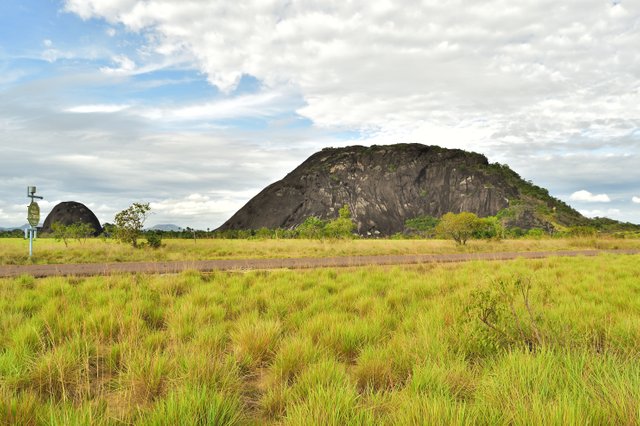Piedra la tortuga / The turtle stone. VEN16
Mitos y costumbres de la amazonía venezolana
• Después de llegar a Puerto Ayacucho capital del estado Amazonas al sureste de Venezuela, se podría pensar que no hay más lugares donde ir; sin duda alguna es la ultima ciudad que se puede acceder por tierra en esta región, pero saliendo de la ciudad, es posible encontrar un variado numero de monumentos naturales. Uno de ellos es la Piedra la Tortuga, que en realidad son dos piedras, localizada en el eje carretero sur, a mitad de camino hacia el puerto de Samariapo y el Tobogán de la Selva -obligatorio lugar a visitar-.
Los pobladores de Puerto Ayacucho, siempre se refieren a ella de una forma u otra cuando se pasa a un costado de la carretera. Desde diferentes perspectivas se puede apreciar con mayor o menor claridad el relieve de la tortuga que se forma entre las piedras y el horizonte, son innumerables las veces que he pasado por esta ruta, pero nunca me había detenido a observarla desde este ángulo y menos a fotografiarla; también tengo que confesar que en mi adolescencia logre ver “la tortuga” después de más de diez intentos, esto ya hace muchos años. El nombre y la analogía con una tortuga se la dieron los indígenas de la zona, he escuchados relatos que van desde una antigua tortuga gigante petrificada hasta historias de dioses ancestrales. Conocer las costumbres de la región y la cosmovisión de la naturaleza, agregan un toque de misterio al disfrutar de este paisaje.
En 1992 recibió el estatus de monumento natural. Fuente
El monumento es sagrado y patrimonio cultural de las etnias Hiwi y Piaroa; alberga petroglifos, testimonios de la actividad cultural que existió en el Amazonas. Fuente
Myths and customs of the venezuelan amazon
• After arriving at Puerto Ayacucho capital of the Amazonas state in the southeast of Venezuela, you might think that there are no more places to go; without any doubt it’s the last city that can be accessed by land in this region, but leaving the city, you can find a variety of natural monuments. One of them is the Piedra la Tortuga in english Turtle Stone, which are really two stones, it’s located on the south road axis, halfway to the port of Samariapo and the Tobogán de la Selva -required place to visit-.
The citizens of Puerto Ayacucho, always refer to the stone when it passes to the side of the road. From different perspectives you can see more or less clearly the relief of the turtle that is formed between the stones and the horizon, there are innumerable times I've gone through this route, but I had never stopped to observe it from this angle and less to photograph it; I also have to confess that in my adolescence, I managed to see "the turtle" after more than ten attempts, this was many years ago. The name and analogy with a turtle was given by the indigenous people of the area, I have heard stories ranging from an ancient petrified giant turtle to stories of ancestral gods. Knowing the customs of the region and the cosmovision of nature, add a touch of mystery to enjoy this landscape.
In 1992 it received the status of natural monument. Source
The monument is a sacred space and cultural heritage of the Hiwi and Piaroa ethnic groups; It houses petroglyphs, testimonies of the cultural activity that existed in the Amazon. Source

Congratulations @cadlth! You have completed the following achievement on the Steem blockchain and have been rewarded with new badge(s) :
Click on the badge to view your Board of Honor.
If you no longer want to receive notifications, reply to this comment with the word
STOPDo not miss the last post from @steemitboard:
Congratulations @cadlth! You have completed the following achievement on the Steem blockchain and have been rewarded with new badge(s) :
Click on the badge to view your Board of Honor.
If you no longer want to receive notifications, reply to this comment with the word
STOPDo not miss the last post from @steemitboard: